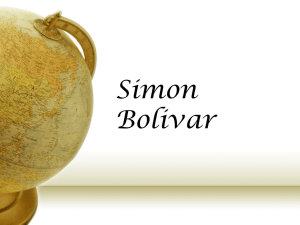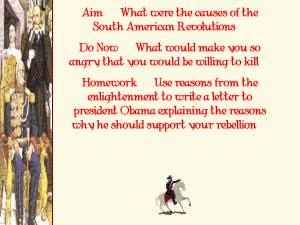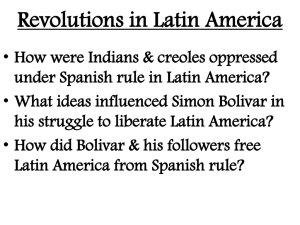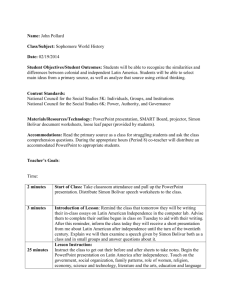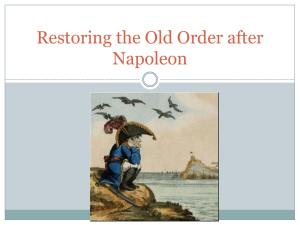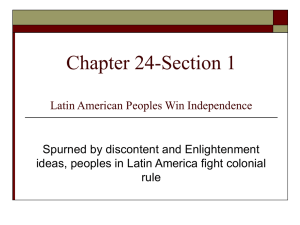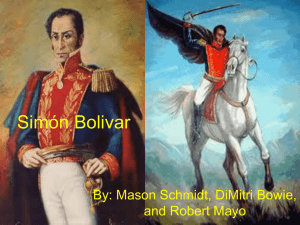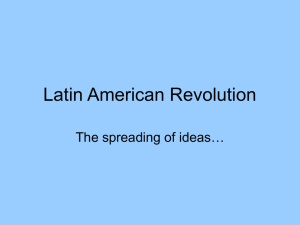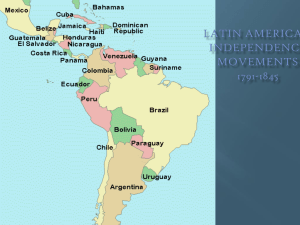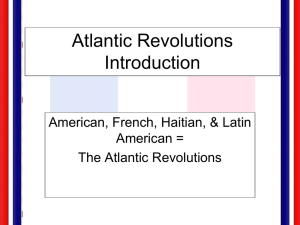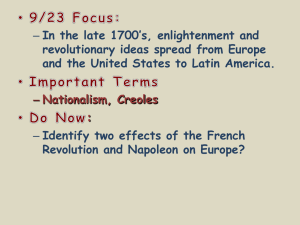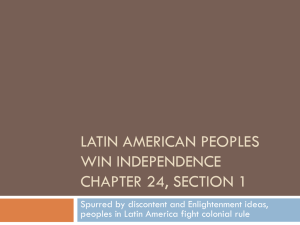Nov 18-22
advertisement
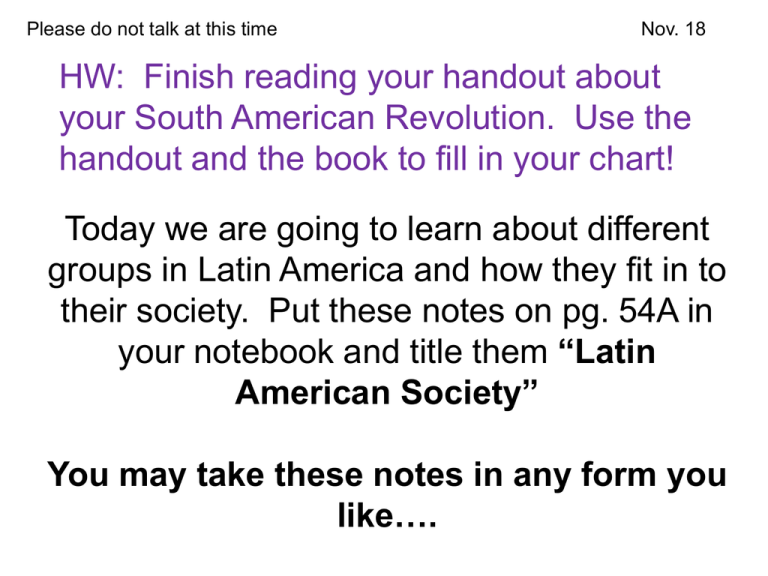
Please do not talk at this time Nov. 18 HW: Finish reading your handout about your South American Revolution. Use the handout and the book to fill in your chart! Today we are going to learn about different groups in Latin America and how they fit in to their society. Put these notes on pg. 54A in your notebook and title them “Latin American Society” You may take these notes in any form you like…. Latin American Revolution Projects We will be doing these Projects on the block day • You will get a chart (pg. 56A)with one of 5 countries from Latin America on it: – – – – – Brazil Mexico Peru Bolivia Venezuela • You are in charge of the country on your chart. Other people will be doing other countries. • Your job tonight is to read the handout on your country and fill in your chart. Step 1: • Use the book pages listed on your chart and the handout for your country to fill in the boxes on your chart • Write VERY neatly or type this up at home later. People will be reading your chart for information. • Make sure all your information is Accurate! Who is in Latin America in the 1800’s? • Europeans from Spain and Portugal (mostly soldiers or fortune seekers and not families) • Native Indians • African Slaves • Mixed race children of the above people How do you think these groups interacted? Reading: Social Hierarchy Ethnic Groups in Latin America • White EuropeansPeninsulares • Whites of European descent- Creole • European and Native Indian mix- Mestizo • European and African mix- Mulatto • Native Indians • African Slaves Still on pg. 53A What Point of View do you think these groups will have about Latin American independence from Europe? • Peninsulares? • Creoles? • Mestizo? Simon Bolivar DBQ- Pg 55A Today we’re going to be talking about Simon Bolivar, who was a military and political figure that played a leading role in Latin America’s struggle for independence. During his lifetime he led Venezuela, Colombia, Panama, Ecuador, Peru, and Bolivia to independence from the Spanish Empire. Through the idea of PanAmericanism, he hoped to unite those countries into a single nation similar to the United States. Though he ultimately failed at this, he is remembered as often remembered fondly as the George Washington of Latin America. Today, we seek to take a more indepth look at this fascinating man, and ask the question “What kind of leader was Simon Bolivar?” Today, we seek to take a more in-depth look at this fascinating man, and ask the question “What kind of leader was Simon Bolivar?” Document A (El Libertador) Close Reading: Describe the painting. What are some if the images, symbols, and characters you see? Describe AT LEAST THREE Close Reading: What do you think is the overall message of this painting? Document A (El Lbertador) Close Reading: Describe the painting. What are some if the images, symbols, and characters you see? Describe AT LEAST THREE Close Reading: What do you think is the overall message of this painting? Document B (Proclamation of 1813) Close Reading: Why have Simon Bolivar and his army come to Venezuela? What are they going to do? What are they not going to do? Explain Close Reading: How does Bolivar say he will deal with the Spanish? How will he deal with the Americans loyal to the Spanish? Do you think this policy is fair? Explain Record your first claim: Based on these documents, what kind of leader was Simon Bolivar? Please do not talk at this time Nov. 19 HW: Bring art supplies for the Block day! Please get out your Bolivar DBQ (pg. 55) and get a folder for your pair. Have your Chart out to be checked off Now back to our analysis of Bolivar! Document C (Scholarly Article) Close Reading: Re-read the first paragraph. What were Simon Bolivar’s social and political goals? Explain. Close Reading: What do you think Bolivar meant when he said Spanish Americans were ‘seduced by freedom’? How is this a bad thing for democracy? Close Reading: Re-read the third paragraph. How does Bolivar view elections? How does this view influence what he includes in the Bolivian Constitution? Close Reading: According to the author, what was the “tragedy” of Simon Bolivar? Explain. Record your second claim: Based on these documents, what kind of leader was Simon Bolivar? Document D (Venezuelan Bolivar) Source: What country is the above currency from? What is the official name of that country? Analyze: Why do you think Venezuela chose to name their currency after Simon Bolivar? What does this say about him as a leader? Document E (Statues) Source: What country and city is statue pictured above from? What other countries have statues of Simon Bolivar? Analyze: Why do you think countries in both Europe and North America also have statues of Simon Bolivar? What does this say about him as a leader? Record your third claim: Based on these documents, what kind of leader was Simon Bolivar? Final Claim: What kind of leader was Simon Bolivar? *Be sure to use EVIDENCE from the documents to support your claim* Share Out! Please do not talk at this time Nov. 20/21 HW: South America Projects Due Friday Please get out your South American Independence Chart (Pg. 56A) Last day to turn in work for 2nd quarter is Dec 2nd . Choose a Product from the list below (or come up with your own idea and get it approved) and use the information you got on your revolution to create something that will teach the class about your revolution in Latin America. • • • • • • • • • • • • • Rap Song or Ballad PPT Lesson Illustration/Painting Board Game Epic Poem Museum Exhibit Short Story Short Skit or Play Letter Home from a Soldier Newspaper Front Page Comic Strip Scrap Book Page Short Children’s Book Step 2: Include as much information as possible from your Graphic Organizer in your Product. You must include AT LEAST: You may also include: More details and specifics Who (countries) participated in How it connects to the American revolution Revolution, French Revolution or Where and when it was fought Napoleon Three main events in the revolution A famous general or leader who Why it started was part of the revolution Results of the revolution Be Neat and Accurate- Other students will be looking at your work INTERPERSONAL LEARNERS: You MUST do your Graphic Organizer on your own, though you may talk it over with a partner. You MAY make your Product with a partner if you clear it with me first. Project Work Time! • Want to go Deeper? • Get a Revolutions flow chart handout. • Use this to get some ideas about how revolutions were connected. Find the Inferences and Cause and Effect Relationships! • Incorporate these into your project! Please do not talk at this time Nov. 22 HW: Finish your Venn Diagram on South American Revolutions Please get out your charts on Latin American Revolutions and your Projects Last day to turn in work for 2nd quarter is Dec 2nd . Take time now… • Look at the Projects people have made. • Read the Revolution Info Charts that go with the projects • Use that information to fill out your Comparison Chart on 4 OTHER revolutions. • Don’t do you own! Now with a highlighter • Highlight those things in your Comparison Chart that these revolutions have in common. • How are they similar? • The parts you have not highlighted show how they are different. Pg. 57B: Compare and Contrast • Compare and Contrast: Show how two things are both similar and different Compare and Contrast Cue Words Show the similarities and differences between two things Contrast in contrast although more than less than instead of However different from Compare same as alike not only…but also either…or likewise similarly similar to compared with as well as resemble Contrast unless on the contrary on the other hand as opposed to but not while Compare/Contrast Sentence Stems Use these sentence stems on pg. 57B to say how two revolutions from your chart were similar and different. • The ___________ and ____________ revolutions were similar in that ____________ because they both____________________. • The ___________ and ___________ revolutions were different because ___________ had _____________ while _______________ had _____________.
